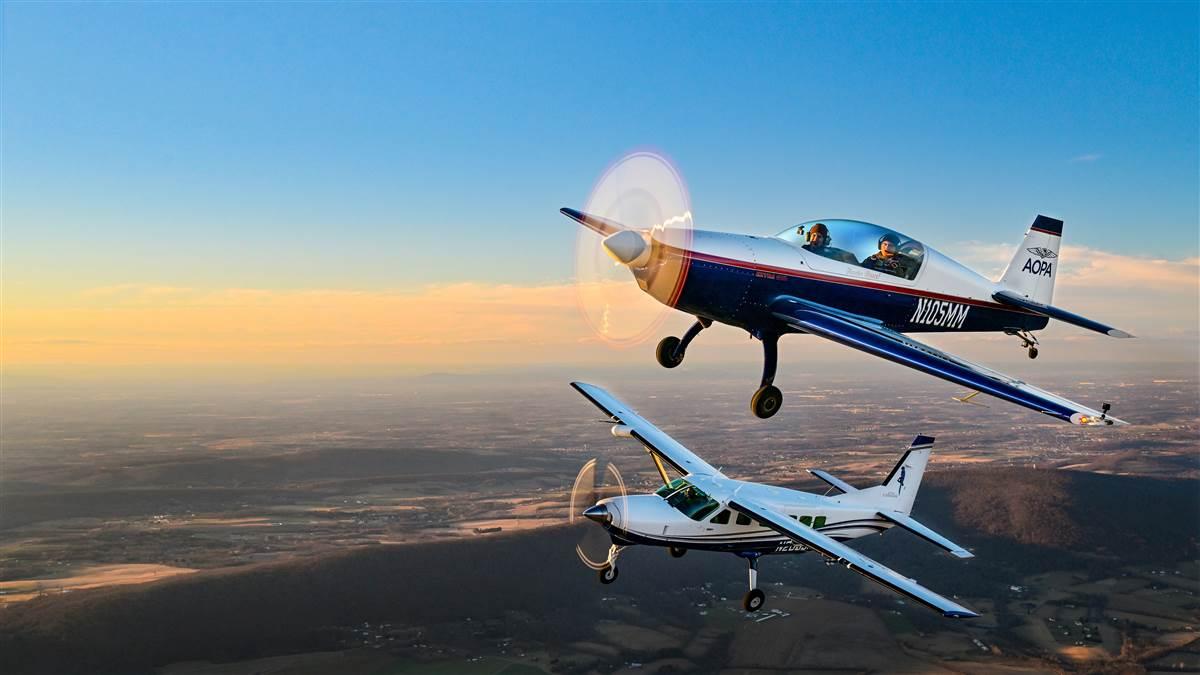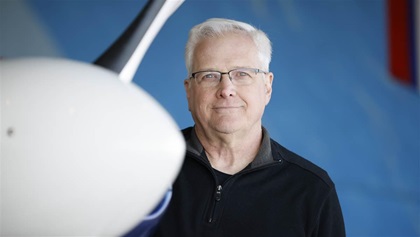Shake, rattle, and roll
A Caravan topples the AOPA Extra 300
This wake turbulence encounter isn’t a surprise. It’s a devilish test in which AOPA
Air Safety Institute (ASI) Senior Vice President Richard McSpadden has intentionally positioned the AOPA Extra 300L directly behind a far larger Cessna 208 Caravan to subject an upset recovery student to a strenuous and purposely unpredictable event. As the Extra gets buffeted and tossed in the swirling air behind the Caravan, McSpadden hands over control to the front-seat pilot, ASI Video Producer Tyler Pangborn, and asks him to recover.
“Your airplane, Tyler,” McSpadden says. “See if you can salvage this mess.”

Photography by David Tulis

 Pangborn, a private pilot with about 250 flight hours including about 1.5 hours of upset recovery training in the AOPA Extra 300L, is momentarily stumped. The Extra is flying at 4,500 feet, 100 KIAS, and it’s rolling quickly
Pangborn, a private pilot with about 250 flight hours including about 1.5 hours of upset recovery training in the AOPA Extra 300L, is momentarily stumped. The Extra is flying at 4,500 feet, 100 KIAS, and it’s rolling quickly
to the left beyond 90 degrees of bank. The nose is 20 degrees below the horizon and dropping.
“OK, airspeed’s increasing,” says Pangborn as he pushes slightly forward on the control stick and pulls the throttle to idle. “Rolling right.”
The Extra rolls slowly at first, then more briskly to wings level. A steady 3G pull on the stick raises the airplane to level flight from a 30-degree dive. The Extra has fallen about 400 feet below the Caravan, and Pangborn pushes the throttle forward to start a climb.
“Give me a left turn so we can rejoin and all do this again,” McSpadden tells the Caravan crew. “This is really great training because, once we move into your wake, I have absolutely no idea what the Extra’s going to do—and that unpredictability is what we’re looking for.”
The question at the heart of this exercise is whether lessons learned during upset recovery training are “sticky.” Will pilots be able to remember and apply them when confronted by stressful and confusing situations that happen weeks, months, or even years later? In Pangborn’s case, he had made an introductory aerobatic flight in the Extra and received ground and air upset recovery training about two months before the wake encounter flight.
When flying behind the Caravan, Pangborn was thrown into a half-dozen wake encounters leading to extreme upsets, and he successfully suppressed the “panic pull” instinct and recovered without excessive altitude loss in all of them.
“Obviously, I knew these upsets were coming, but there was still a bit of shock factor when they actually took place,” Pangborn said. “They were pretty severe. I was glad that I had the presence of mind to remember my training: push to lower the wing angle of attack, and then roll to the nearest horizon. My reactions were a little slower than I would’ve liked, and I’m sure I’d benefit from more training. But it was good to know I can call upon the lessons I’ve learned so far.”
McSpadden said he’s certain that the pilots who have undergone upset training will quickly recognize in-flight upsets. But periodic training is required to reinforce proper recovery technique—especially in non-aerobatic airplanes with far less control authority than the Extra.
“Imagine being thrown into a heavy bank, almost inverted and nose down in a high-wing trainer,” he said. “That would be a much more difficult and demanding situation because the pilot would have less effective flight controls and redline airspeeds could be a real factor. The concepts are transferable, but training must emphasize how much more difficult it will be to recover a less maneuverable airplane.”
Indelible impression
The AOPA Extra 300L donated by Bruce Williams has been an exceptional teacher during the year and a half the association has had it. It’s been featured in a variety of AOPA and ASI technique articles and videos, and proceeds from its sale will benefit AOPA initiatives such as protecting pilots’ freedom to fly in the United States and air safety.
The unlimited aerobatic airplane has been displayed at aviation events including the Sun ’n Fun Aerospace Expo and EAA AirVenture in 2022. Its avionics were upgraded by Southeast Aero with three Garmin GI 275 attitude instruments that don’t tumble during aerobatic flight, and a Garmin GNC 355 nav/com. Having glass-panel instruments in both the front and rear make the airplane exceptionally well suited for unusual attitude training, and AOPA has provided a great deal of that.
Some of its more memorable flights were taking educators who teach the AOPA High School aviation curriculum for aerobatic flights. Another highlight was a surprise flight for Alton Downer, a flight student and lineman at Frederick Municipal Airport who’s also a U.S. Army combat veteran.
The AOPA Extra 300L introduced McSpadden, a career U.S. Air Force fighter pilot and former leader of the Thunderbirds demonstration team, to competition-style aerobatics that involve negative Gs, spins, and tumbles.
“Those aspects were all new to me,” he said, “and they’re all fun to learn—except for the negative Gs. Those are just painful.”
Personally, the AOPA Extra flights that stand out were the very first ones, because the airplane makes such an indelible impression. You strap in and cinch yourself tight against the leather seat with a ratcheting harness. The ergonomic refinement and optically perfect glass inspire confidence in the airplane itself. The Lycoming IO-540 engine starts obediently and lopes at idle like a 1970s muscle car. The three-blade MT prop hisses like a rattlesnake and tears into the air with smooth savagery. The exquisite control harmony and its lightness and responsiveness allow precise, nearly effortless placement.
“Just think about where you want to be,” McSpadden says, “and the airplane goes there.”
I ferried the airplane from Nevada to Maryland in late December 2021, on the shortest days of the year, and those flights were both strenuous and comical. Shivering at 11,500 feet with numb toes and fingers, I’d bemoan the airplane’s draftiness and lack of a cabin heater or autopilot. Each leg was about three flight hours, and whenever I’d try to take a swig of Gatorade or unwrap a Snickers bar, I’d end up 30 degrees off heading and hundreds of feet high or low. Four long legs and the aid of a booming tailwind got me home on Christmas Eve, and that seemed an appropriate date because the airplane itself is such an extraordinary gift.
Bruce Williams, a veteran flight instructor and former Microsoft manager, taught aerobatics and upset recoveries in the airplane for the 20 years he owned it—and hundreds of students benefited from the lessons he and the Extra imparted. We at AOPA have tried to honor Williams’ record by continuing to teach in it, and producing videos aimed at enhancing flight education.
Soon, it will be someone else’s turn, and our gratitude and high hopes will fly with them. [email protected]
Auction Item







